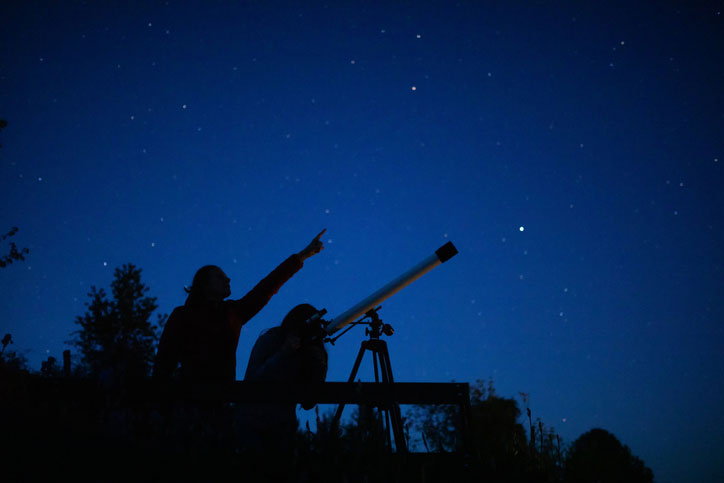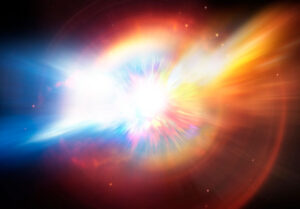

“We are a way for the universe to know itself.”
- Carl Sagan
What Carl Sagan was getting at is less enigmatic that it might sound at first – humanity is a carbon-based life made from supernova material blasted out from carbon-factory supergiant stars… without those supernova ingredients, we wouldn’t be here to study astronomy.
In fact, astronomy can be defined in terms of anthropology, history, culture, ethnography, and science. Every human culture has looked to the sky to make sense of how their own existence fit in with the stars. This goes to the very heart of what it means to study astronomy in the context of a liberal arts and sciences education.
And this extends right up through the present day with modern science. Today the best hope of testing theories on the nature of sub-atomic particles smashed together at near-light speed in accelerators like CERN comes from gazing at galaxies through the most advanced on and off-world telescopes the world has ever known.
Coursework in Astronomy is Right at Home in a Liberal Arts Curriculum
It was a mere hundred years ago that we learned there are multiple galaxies besides our own in the universe thanks to Edwin Hubble. Just 30 years ago there was no confirmation that planets existed outside our own solar system.
- We’ve confirmed the existence of nearly 5,000 exoplanets
- The latest data shows it’s likely that at least every-other star has a planetary system
- For every sun-like star out there, about half have a planet in their habitable zone
Observations from Kepler’s next-generation successor, the James Webb Space Telescope, will further the exciting tradition of astronomy’s exponentially-increasing discoveries. This mission’s purview includes the search for bio- and techno-signatures of life on other planets.
In a Liberal Arts Degree Program, the Study of Astronomy Intersects with Anthropology and Ethnography
 Astronomy in pop-culture conjures the image of a Middle-Ages European aristocrat scribbling down sky observations on a parchment, and today the image of a lone person pulling an all-nighter on top of a mountain in a dark observatory. But in reality, the roots of astronomy stretch back even to pre-history.
Astronomy in pop-culture conjures the image of a Middle-Ages European aristocrat scribbling down sky observations on a parchment, and today the image of a lone person pulling an all-nighter on top of a mountain in a dark observatory. But in reality, the roots of astronomy stretch back even to pre-history.
A Liberal Arts Education Makes a Meaningful Connection Between Astronomy and Ancient Cultures
Many cultures have a folk myth describing the constellation we know as the Pleiades. Eighth-century Japanese astronomers named this constellation Mutsuraboshi, meaning “six stars.” That’s fitting, because with the naked eye the constellation has six visible stars tightly grouped together.
What’s strange is that in many cultures spread across the world, the number seven is associated with the Pleiades:
- The Vikings had a myth explaining the constellation as six brothers and a princess they’d rescued; today in modern Danish the name has migrated and simply means “seven star.”
- The ancestors of modern-day Dakota and Nakota cultures told a folk story about the constellation, describing seven youths who climbed a spider web to the heavens.
- The Cherokee, Cheyenne, Lakota, and many other Native American peoples also feature the number seven prominently.
- In Malaysia, the constellation is referred to as “seven stars.”
- In Thailand the constellation is told to represent seven chickens.
- Indigenous Aboriginal people of Australia also feature the number seven in their myths.
- Even the ancient Greeks, from where we get the name, explained the constellation with a mythological tale about seven sisters who were daughters of Atlas and the sea nymph Pleione.
But why does the number seven come up so much for a constellation with only six stars? One astrophysicist in Australia, Ray Norris, has developed a fascinating theory along with his co-author Dr. Barnaby Norris. And as you might suspect when considering it in the context of classic liberal arts studies, it has as much to do with perspective as it does the mechanics of the universe.
The Norris’ points out that many of the stars as we see today were in different positions 100,000 years ago when humans were living in Africa, having not yet migrated across the globe. Back then there were seven visible stars in the Pleiades constellation. With homo sapiens primarily confined to Africa at this time, they developed their folktales about the seven stars and took those stories with them as they migrated across the continents. Their oral traditions stayed with the prehistoric human tribes over thousands of years and across continents as a folktale relic, even while the stars in the constellation gradually changed to six.
It’s a fascinating and even poignant theory that could represent the most enduring link many different cultures have with each other stretching back to our common history in Africa. But this is far from the only prehistoric references humans have shown astronomy.
Seeing a supernova with the naked eye from earth is a rare event. There have been less than 10 over the course of all written history. But when these massive explosions occur, they can outshine all other stars in the sky and last for a few weeks. When Betelgeuse goes nova, which it will do relatively soon on an astronomical timescale, it may be so bright that you can see it during the day and read a book by it at night. And naturally these rare events stood out to prehistoric peoples.
Between 4,100 and 6,100 years ago a hunter in Kashmir drew a scene on a rock showing two bright celestial objects overhead. It’s now theorized the two objects were the moon and the first-ever human record of a supernova. A pictograph in Chaco Canyon, New Mexico is also theorized to have been made by the ancestors of the Pueblo people to commemorate a supernova in the 11th century. And these are just a few examples.
Astronomy as Part of a Liberal Arts Degree Program Offers a Lens for Understanding History, Civilization, and Empires
Take a quick glance at any star chart you’ll see that many have still kept their Arabic names right through the present day. Among the top-10 brightest stars in the night sky, four take their names from Arabic: Rigil Kentaurus, Achernar, Rigel, and Vega. Some of the best astronomical historical records have been maintained by the Chinese for 3,000 years. India’s religious Vedas texts dealing with astronomy are at least 3,500 years old and were traditionally part of Hindu study.
Studying Astronomy in the Context of a Liberal Arts Education Reveals a Lot About Who We Are and How We Understand the Universe
 The most well-recorded supernova in history was in 1054. This also happened to be the time of the Great Schism when the Eastern Orthodox Church split from the Roman Catholic Church. At the time, the Byzantine Empire minted coins with the supernova on it in an image of two stars, and used this celestial event as a heavenly sign that the split was divine will.
The most well-recorded supernova in history was in 1054. This also happened to be the time of the Great Schism when the Eastern Orthodox Church split from the Roman Catholic Church. At the time, the Byzantine Empire minted coins with the supernova on it in an image of two stars, and used this celestial event as a heavenly sign that the split was divine will.
The Mayan civilization paid particular attention to astronomy, elevating it as something to be studied by the priestly class. The movement of heavenly bodies was considered of the utmost importance for forecasting future events and as such the state invested heavily in astronomy to the point that many of their measurements were more precise than any prior civilization’s in the past or would be for hundreds of years to come. The reasoning was if a battle victory occurred during a lunar eclipse then lunar eclipses would be a good time to stage future battles.
In fact, the Mayans had all the celestial measurements and know-how they needed to discover what Issac Newton would over a century later when he spawned the entire classical mechanics branch of science that changed Western Civilization. However, the purpose for the Mayan’s study of astronomy was different than Newton’s, and therefore so were the outcomes.
These all stand as the earliest examples of what it means to study astronomy in the context of a liberal arts college degree program today. Though some of these examples predate the idea of liberal studies originally conceptualized by the ancient Greeks, they reflect the same kind of interdisciplinary approach to understanding the world.
It’s an Exciting Time to Study Astronomy as Part of a Liberal Arts and Sciences Degree Program
Advances in astronomy are progressing at breakneck speed, and these have implications for our understanding of our place in the universe and advanced science. It should go without saying that liberal arts colleges are the proving grounds for many of the theories in modern astronomy.
If life is out there, we’ll soon have the equipment we need to detect it thanks to projects like the Transiting Exoplanet Surveying Satellite, the James Webb Space Telescope, and the Vera Rubin Observatory. While most scientists expect that if life is detected it will be in the form of microbes giving off organic gasses, even this discovery would fundamentally reshape fields like philosophy and religion. And it goes without saying that detecting signs of intelligent life would be the most important discovery in human history.
From LIGO to CERN, the Liberal Studies Model of Enquiry Puts Theory to the Test
 Today astronomy is also key in pushing our understanding of quantum mechanics and the search for a unifying theory between it and general relativity. All grist for the mill in a liberal studies degree program
Today astronomy is also key in pushing our understanding of quantum mechanics and the search for a unifying theory between it and general relativity. All grist for the mill in a liberal studies degree program
In 2015 a collision of two black holes 1.3 billion light years away was detected by gravity waves at the Laser Interferometer Gravitational-Wave Observatory (LIGO). This was the first time the general theory of relativity was confirmed in this way. Resulting in a Nobel Prize, it marked the birth in-earnest of the field of gravitational wave astronomy.
Another Nobel Prize-worthy discovery was made in 2012 at CERN with the discovery of the Higgs boson particle. This has led physicists and astronomers to develop new theories and models to explain the fundamental properties of matter, using astronomical observations as a testing ground. Astronomical discoveries in this field will not only further our understanding of quantum mechanics; they may also lead to important breakthroughs in technologies like quantum computing that will have enormous impacts on everyone’s lives.
In the near future, astronomers are hoping to use data from new collider experiments to understand the nature of dark matter, which makes up an estimated 85 percent of the physical matter in the universe. That’s 85 percent of the physical universe that exists but that we cannot see directly with any known instruments, however we have clear images of the effect from the Hubble telescope.
Astronomy is a quintessential liberal art. It seeks to explain how we fit in with the universe, encompassing subjects like religion, philosophy, history, mathematics, anthropology, and science.






